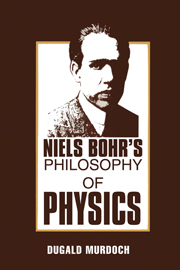Book contents
- Frontmatter
- Contents
- Dedication
- Preface
- Acknowledgements
- 1 Wave-particle duality
- 2 Niels Bohr and wave-particle duality
- 3 From duality to complementarity
- 4 The meaning of complementarity
- 5 The foundations of kinematic-dynamic complementarity
- 6 Bohr's theory of measurement
- 7 Bohr's theory of properties
- 8 Einstein versus Bohr
- 9 The sequel to the Bohr-Einstein debate
- 10 Bohr's philosophy of physics
- 11 An appraisal of Bohr's philosophy of physics
- Notes
- Index
3 - From duality to complementarity
Published online by Cambridge University Press: 01 June 2011
- Frontmatter
- Contents
- Dedication
- Preface
- Acknowledgements
- 1 Wave-particle duality
- 2 Niels Bohr and wave-particle duality
- 3 From duality to complementarity
- 4 The meaning of complementarity
- 5 The foundations of kinematic-dynamic complementarity
- 6 Bohr's theory of measurement
- 7 Bohr's theory of properties
- 8 Einstein versus Bohr
- 9 The sequel to the Bohr-Einstein debate
- 10 Bohr's philosophy of physics
- 11 An appraisal of Bohr's philosophy of physics
- Notes
- Index
Summary
Bohr's response in 1925 to the failure of the Bohr–Kramers–Slater theory was, as we have seen, to regard wave–particle duality as having a formal, rather than realistic, significance; he saw it as a ‘limitation of our usual means of visualization’. That same year, however, wave–particle duality was generalised by Louis-Victor de Broglie to cover the theory of matter. Moreover, the advent of quantum mechanics (i.e. matrix mechanics and wave mechanics), rather than dispelling the duality problem, heightened it. How did Bohr respond to these new developments in the quantum theory?
A matter of waves
In the autumn of 1923 de Broglie put forward the extremely bold hypothesis that any particle whatever is associated with a wave whose wavelength λ and frequency ν are proportional to the particle's momentum and energy respectively: λ = h/p, v = E/h. De Broglie regarded his hypothesis as the basis of a new mechanics, a wave mechanics related to classical mechanics in the same way as wave optics is related to ray optics. On this view the trajectory of a particle corresponds to the ray of the wave associated with it (i.e. the normal to the equiphase surface of the wave), and the velocity of the particle corresponds to the group velocity of the wave. De Broglie suggested, moreover, that in certain circumstances particles should exhibit diffraction effects: a stream of electrons, for example, which passes through a slit in a screen should undergo diffraction.
- Type
- Chapter
- Information
- Niels Bohr's Philosophy of Physics , pp. 34 - 56Publisher: Cambridge University PressPrint publication year: 1987
- 1
- Cited by



